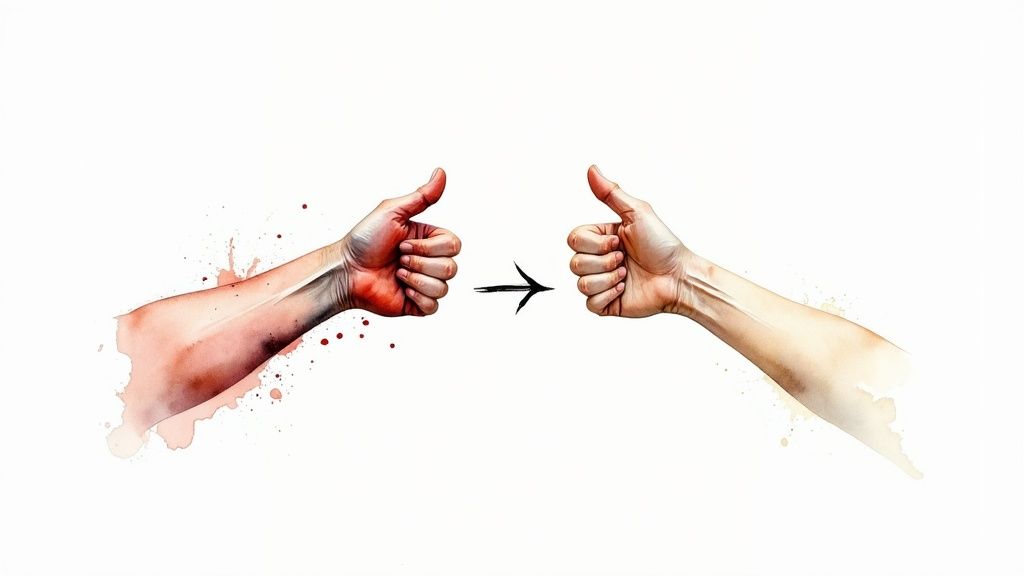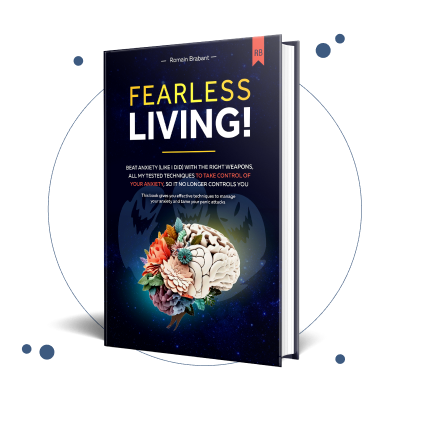
Anxiety can feel like a life sentence, trapping you in a relentless cycle of fear, worry, and physical tension. But what if you could do more than just cope? What if you could truly heal and build a life free from the grip of panic? This isn't just wishful thinking; it's an achievable reality. The journey from constant dread to fearless living is paved with practical, evidence-based tools that empower you to reclaim control over your mind and body.
This guide moves beyond generic advice to give you a comprehensive list of powerful anxiety management strategies. We provide actionable steps you can start implementing today. This isn't about simply 'toughing it out' or ignoring your feelings. It is about learning the skills to dismantle anxiety at its core, understanding its triggers, and responding with confidence rather than fear.
Each strategy detailed below is a stepping stone on your path to lasting peace. They offer a tangible sense of hope that a calmer, more joyful life is not only possible but well within your reach. Let’s explore the specific, proven tools that will help you build that panic-free life, one technique at a time.
1. Deep Breathing & Diaphragmatic Breathing
One of the most immediate and effective anxiety management strategies is learning to control your breath. Deep, diaphragmatic breathing is a powerful, science-backed technique that directly communicates with your nervous system, signaling it to shift from a state of high alert to one of calm and safety. This foundational practice can be a reliable anchor, assuring you that it is possible to regain control and live panic-free.
When you feel anxious, your breathing often becomes shallow and rapid, activating the "fight-or-flight" response. Diaphragmatic breathing counteracts this by stimulating the vagus nerve, which activates your parasympathetic nervous system, also known as the "rest-and-digest" system. This simple act lowers your heart rate, reduces blood pressure, and decreases levels of the stress hormone cortisol, providing tangible relief in moments of distress.

How to Practice Diaphragmatic Breathing
Mastering this technique is straightforward and can be done anywhere, anytime.
- Find a comfortable position, either sitting or lying down.
- Place one hand on your chest and the other on your belly, just below your rib cage.
- Inhale slowly through your nose for a count of four. Feel your belly rise and push your hand up. The hand on your chest should remain relatively still.
- Hold your breath for a moment.
- Exhale slowly through your mouth for a count of six, feeling your belly fall.
This method is used by high-performers from Navy SEALs (box breathing) to healthcare workers in high-stress shifts. Starting with just five minutes of daily practice can build the muscle memory needed to deploy this tool effectively when anxiety strikes.
2. Cognitive Behavioral Therapy (CBT) Techniques
Beyond managing physical symptoms, one of the most powerful anxiety management strategies involves changing the underlying thought patterns that fuel the anxiety cycle. Cognitive Behavioral Therapy (CBT) is a structured, evidence-based approach that empowers you to identify, challenge, and reframe the negative thoughts and behaviors contributing to your anxiety. This approach provides a practical roadmap to dismantle anxious thinking, offering profound hope that you can reshape your relationship with anxiety and live a more peaceful life.
CBT operates on the principle that your thoughts, feelings, and actions are interconnected. By learning to recognize and question distorted thoughts, such as catastrophic thinking or overgeneralization, you can fundamentally alter your emotional response. This highly effective method is used in settings from NHS digital programs to corporate wellness initiatives, helping millions develop healthier coping mechanisms. It shifts you from being a passive recipient of anxiety to an active participant in your own recovery.

How to Practice CBT Techniques
Integrating CBT into your daily life can be done with simple, consistent exercises. These skills build resilience, allowing you to intercept anxious thoughts before they spiral.
- Keep a thought journal: Write down situations that trigger anxiety, the automatic thoughts that arise, and your emotional response. This helps you identify recurring negative patterns.
- Challenge your thoughts: For each negative thought, practice the "evidence for and against" technique. Ask yourself, "What proof do I have that this thought is true? What proof do I have that it isn't?"
- Set small behavioral goals: Instead of avoiding situations that cause anxiety, create small, manageable steps to face them. This is known as exposure therapy, a key component of CBT.
- Use dedicated apps: Tools like MindShift CBT or Sanvello provide guided exercises and daily prompts to help you practice these skills consistently.
By applying these structured techniques, you gain the skills to question the validity of your anxious mind, creating a crucial space between a trigger and your reaction. To explore this powerful therapy in more detail, you can find a comprehensive guide on understanding CBT for anxiety.
3. Progressive Muscle Relaxation (PMR)
Progressive Muscle Relaxation (PMR) is a powerful mind-body technique designed to release the physical tension that often accompanies anxiety. This systematic practice involves intentionally tensing and then relaxing specific muscle groups, helping you become acutely aware of the physical sensations of stress and calm. By learning to recognize and release this stored tension, you can effectively short-circuit the physical component of the anxiety cycle, offering profound relief and a renewed sense of control.
This evidence-based method, developed by Dr. Edmund Jacobson, operates on the simple principle that mental calmness is a natural result of physical relaxation. When you're anxious, your muscles tighten unconsciously. PMR reverses this process, sending powerful relaxation signals to your brain that help soothe your nervous system. This approach is not just a temporary fix; it’s a skill that builds resilience, empowering you with the knowledge that you can actively create a state of peace within your own body, a crucial step toward living panic-free.

How to Practice Progressive Muscle Relaxation
You can perform this exercise discreetly, making it one of the most versatile anxiety management strategies available.
- Find a quiet space and get comfortable, either sitting or lying down.
- Begin with your feet. Tense the muscles in your feet and toes for 5 seconds, focusing on the feeling of tightness.
- Release the tension completely and notice the contrast as your muscles go limp. Stay in this relaxed state for 10-15 seconds.
- Move up your body, systematically tensing and relaxing muscle groups one at a time: legs, abdomen, arms, hands, shoulders, and face.
PMR is used effectively in diverse high-stress environments, from corporate wellness programs to chronic pain clinics. Starting with a 10-minute guided audio can help you master the sequence. With regular practice, you will become so attuned to your body that you can release tension in specific areas (like your jaw or shoulders) before it escalates into full-blown anxiety.
4. Mindfulness Meditation
Mindfulness meditation is a powerful anxiety management strategy rooted in ancient tradition but now widely validated by modern science. It involves training your attention to focus on the present moment, observing your thoughts, feelings, and bodily sensations without judgment. This practice creates a crucial space between an anxious trigger and your reaction, allowing you to respond thoughtfully rather than being swept away by panic. It offers a path to not just manage anxiety, but to fundamentally change your relationship with it, proving that a calm and centered life is within reach.
By consistently practicing mindfulness, you learn to recognize anxious thoughts as temporary mental events, not absolute truths. This process, known as cognitive defusion, helps detach your sense of self from the overwhelming feelings anxiety can create. Endorsed by pioneers like Jon Kabat-Zinn, this technique is now used in high-stress environments, from Google's corporate wellness programs to military PTSD treatment, demonstrating its effectiveness in building resilience and promoting mental clarity.

How to Practice Mindfulness Meditation
Getting started is simple and requires no special equipment, only a commitment to being present. You can learn more about using meditation for anxiety relief to deepen your understanding.
- Start small, committing to just five minutes each day, and gradually increase the duration as you feel comfortable.
- Use guided meditations from apps like Headspace, Calm, or Insight Timer to help direct your focus.
- Find a consistent time and place for your practice to help build it into a regular habit.
- Remember that your mind will wander. The goal is not to have a perfectly clear mind, but to gently and kindly bring your attention back to your breath whenever you notice it has strayed.
Beyond formal meditation, engaging in physical practices that foster a mind-body connection can significantly reduce anxiety. Consider exploring the many benefits of a daily yoga practice to complement your mindfulness routine and enhance your journey toward a panic-free life.
5. Regular Physical Exercise
Engaging in regular physical exercise is one of the most powerful and accessible anxiety management strategies available. It acts as a natural anxiolytic, directly combating the physiological and psychological symptoms of anxiety. Structured physical activity provides a healthy outlet for nervous energy, releases mood-boosting endorphins, and reduces levels of stress hormones like cortisol, offering a pathway to reclaim control over your body and mind.
The science, championed by experts like Dr. John Ratey, shows that exercise sparks profound neurochemical changes that improve mood and resilience. It’s not just about burning off stress; it's about rebuilding your brain to be less susceptible to anxiety. This proactive approach reinforces the empowering reality that you can actively reshape your mental state and live a life unburdened by panic.
How to Incorporate Exercise for Anxiety Relief
Integrating movement into your routine doesn't require an intimidating gym membership or hours of intense training. The key is consistency and finding what works for you.
- Start small and build momentum. Begin with just 10-15 minutes of brisk walking each day. The goal is to create a sustainable habit, not to push yourself to exhaustion.
- Choose activities you genuinely enjoy. Whether it's dancing, hiking, swimming, or team sports, enjoyment ensures you'll stick with it long-term.
- Combine physical and mental benefits. Consider practices like yoga or tai chi, which integrate movement, breathing, and mindfulness for a holistic approach to anxiety reduction.
- Exercise with a friend. Social support provides motivation and accountability, turning a solitary task into a connecting experience.
From corporate wellness programs that have seen employee anxiety drop by 25% to running groups specifically for individuals with anxiety disorders, the evidence is clear. Consistent physical activity is a foundational strategy for managing anxiety and building a panic-free life.
6. Grounding Techniques (5-4-3-2-1 Method)
When anxiety pulls you into a spiral of worry or a full-blown panic attack, it can feel like you’ve lost connection with reality. Grounding techniques are powerful, sensory-based anxiety management strategies designed to pull you out of your head and back into the present moment. The 5-4-3-2-1 method is a widely-used and effective tool that anchors you to your immediate environment, providing a sense of control and safety.
This technique interrupts the anxious thought cycle by redirecting your focus to the concrete, tangible world around you. By engaging all five senses, you send a direct message to your brain that you are safe and not in immediate danger. This practice is a cornerstone of trauma-informed care and is used by crisis responders and therapists to help people regain composure, demonstrating its power to help you live panic-free.
How to Practice the 5-4-3-2-1 Method
This technique is incredibly simple and can be performed discreetly wherever you are.
- Acknowledge 5 things you can see. Look around and mentally name five objects. Notice their color, shape, and size. For example, "I see my blue pen, a crack in the ceiling, a green plant."
- Acknowledge 4 things you can feel. Tune into the sensation of touch. Notice the texture of your clothes, the feeling of the chair supporting you, or the temperature of the air on your skin.
- Acknowledge 3 things you can hear. Listen carefully and identify three distinct sounds. It could be the hum of a computer, birds chirping outside, or the distant sound of traffic.
- Acknowledge 2 things you can smell. Try to identify two scents in your environment, pleasant or neutral. This might be the smell of coffee, soap, or even the faint scent of paper.
- Acknowledge 1 thing you can taste. Focus on one thing you can taste. You could take a sip of water, chew a piece of gum, or simply notice the current taste in your mouth.
Practicing this when you are calm helps build the skill so it becomes an automatic reflex during moments of high anxiety. For a deeper dive into this and other sensory-based tools, you can explore more about grounding techniques on anxietychecklist.com.
7. Journaling and Expressive Writing
One of the most profound anxiety management strategies is the simple act of putting pen to paper. Journaling and expressive writing offer a therapeutic outlet to untangle the complex web of thoughts and feelings that fuel anxiety. This practice helps you externalize internal worries, creating a crucial emotional distance that allows for greater clarity and insight. It is a powerful method for understanding your own mind and reclaiming your narrative, assuring you that a life free from the grip of panic is attainable.
Pioneered by researchers like Dr. James Pennebaker, expressive writing is scientifically shown to reduce stress and improve well-being. By writing down your deepest thoughts and feelings about an anxious event, you are not just venting; you are actively processing the experience. This structured reflection helps to organize chaotic thoughts, identify recurring triggers, and diminish the emotional charge of your worries. It transforms abstract fears into concrete words that you can examine, understand, and ultimately manage.
How to Practice Expressive Writing
Getting started with journaling requires no special skills, only a willingness to be honest with yourself. The key is consistency, not perfection.
- Set aside 15-20 minutes each day. Find a quiet space where you won't be interrupted.
- Write continuously without editing. Don't worry about grammar, spelling, or structure. The goal is to let your thoughts flow freely onto the page.
- Try different styles. Experiment with gratitude journaling (listing things you're thankful for), worry journaling (dedicating a specific time to write out all your worries), or stream-of-consciousness writing.
- Use prompts if you feel stuck. Start with phrases like, "Today, my anxiety feels like…" or "The main thing I'm worried about is…"
- Review your entries periodically. Look for patterns in your thoughts, emotions, and behaviors to gain a deeper understanding of your anxiety triggers.
This practice is used effectively in diverse settings, from university counseling programs to corporate wellness initiatives. Committing to this small daily ritual can provide invaluable self-awareness and become a cornerstone of your journey to living panic-free. Learn more about the benefits of journaling for anxiety and how to begin your own practice.
8. Time Management and Organization
A chaotic schedule and an endless to-do list can create a powerful sense of being overwhelmed, which is a major trigger for anxiety. Time management and organization are crucial anxiety management strategies that restore a sense of control and predictability to your life. By creating structure, you transform a mountain of overwhelming responsibilities into a series of manageable, actionable steps, proving to yourself that you can handle what comes your way and live without constant stress.
This approach works by reducing cognitive load and decision fatigue. When your tasks, appointments, and goals are captured in a reliable system outside of your head, your mind is freed from the anxious loop of trying to remember everything. This systematic planning directly counters the feelings of helplessness that fuel anxiety, creating a structured environment where you feel empowered and capable, not panicked.
How to Practice Effective Time Management
Implementing an organizational system can be a game-changer for your mental well-being.
- Use the Two-Minute Rule: Popularized by David Allen, if a task takes less than two minutes to complete, do it immediately. This prevents small tasks from piling up.
- Batch Similar Tasks: Group related activities together. For instance, answer all your emails in one dedicated block of time rather than sporadically throughout the day.
- Schedule Buffer Time: Avoid back-to-back commitments. Building in 15-minute buffers between meetings or tasks allows for transitions and prevents the stress of running late.
- Choose Your Tool: Whether it's a digital app like Asana and Todoist or a simple paper planner, find a system that works for you and use it consistently.
These methods are used by everyone from corporate leaders managing complex projects to students navigating academic deadlines. By structuring your time, you are not just organizing your day; you are building a predictable and safe foundation that significantly lowers your baseline anxiety.
9. Lifestyle Modifications (Sleep, Diet, Caffeine)
Your daily habits are the building blocks of your mental well-being, and making strategic lifestyle modifications is one of the most powerful anxiety management strategies available. Optimizing your sleep, nutrition, and intake of stimulants directly impacts your brain chemistry and nervous system regulation. This holistic approach provides a stable physiological foundation, making it easier to manage anxious thoughts and live a calm, panic-free life.
Chronic sleep deprivation, blood sugar spikes, and excessive caffeine all place your body in a state of high alert, mimicking and exacerbating the "fight-or-flight" response. By consciously improving these areas, you reduce the physiological stress load on your system. This proactive strategy, championed by neuroscientists like Dr. Andrew Huberman and sleep expert Dr. Matthew Walker, empowers you to create an internal environment that is naturally resilient to anxiety.
How to Implement Lifestyle Modifications
Small, consistent changes can lead to profound improvements in your anxiety levels.
- Prioritize Sleep Hygiene: Aim for 7-9 hours of quality sleep. Create a relaxing bedtime routine, avoid screens an hour before bed, and ensure your bedroom is dark, cool, and quiet. Keeping a sleep diary can help you identify patterns that disrupt your rest.
- Balance Your Nutrition: Eat regular, balanced meals to stabilize your blood sugar. Studies on diets like the Mediterranean diet have shown a correlation with reduced anxiety. Focus on whole foods, lean proteins, and complex carbohydrates.
- Manage Stimulant Intake: Caffeine is a major anxiety trigger for many. Try limiting your intake, especially after 2 PM, to prevent it from interfering with your sleep and keeping your nervous system on edge.
These adjustments are not about perfection but about progress. By building healthier routines, you are actively rewiring your body's response to stress. Learn more about how lifestyle and diet changes can support anxiety management.
Anxiety Management Strategies Comparison
| Technique | Implementation Complexity 🔄 | Resource Requirements ⚡ | Expected Outcomes 📊 | Ideal Use Cases 💡 | Key Advantages ⭐ |
|---|---|---|---|---|---|
| Deep Breathing & Diaphragmatic Breathing | Low – easy to learn and practice | Minimal – no equipment needed | Immediate anxiety relief, physiological calm | Anytime, anywhere, quick anxiety relief | Quick effect, discreet, scientifically supported |
| Cognitive Behavioral Therapy (CBT) Techniques | High – structured, requires active effort | Moderate to high – therapist or apps | Long-term anxiety reduction, cognitive change | Clinical treatment, structured skill-building | Evidence-based, addresses root causes |
| Progressive Muscle Relaxation (PMR) | Moderate – requires time and quiet | Minimal – guided audio helpful | Reduced physical tension, improved sleep | Relaxation-focused, chronic anxiety, sleep issues | Combines mental/physical relief, easy to adapt |
| Mindfulness Meditation | Moderate – consistent daily practice | Low – apps or silent space needed | Gradual emotional regulation and insight | Anxiety with rumination, emotional regulation | Neuroscience-backed, versatile practice |
| Regular Physical Exercise | Moderate – time and scheduling needed | Moderate to high – may need gear/facilities | Improved mood, neurochemical anxiety reduction | General anxiety, energy release, social support | Natural mood booster, multifaceted health benefits |
| Grounding Techniques (5-4-3-2-1 Method) | Low – simple sensory steps | None | Immediate relief during panic or dissociation | Panic attacks, dissociative episodes, grounding | Immediate, easy to remember, usable anywhere |
| Journaling and Expressive Writing | Low to moderate – requires time and discipline | Minimal – pen, paper or digital device | Insight into triggers, emotional release | Self-reflection and tracking anxiety patterns | Improves self-awareness, inexpensive |
| Time Management and Organization | Moderate – initial setup and habit building | Low to moderate – apps or planners | Reduced overwhelm, increased productivity | Overwhelm from tasks, deadline anxiety | Creates control and routine, prevents stress |
| Lifestyle Modifications (Sleep, Diet, Caffeine) | Moderate – requires sustained behavior change | Variable – possible professional help | Long-term physiological anxiety reduction | Overall anxiety management, physical health focus | Sustainable, addresses root physiological causes |
Build Your Personalized Toolkit for Fearless Living
You have just navigated a comprehensive collection of evidence-based anxiety management strategies, from the immediate, body-based calm of diaphragmatic breathing and progressive muscle relaxation to the mind-altering power of CBT and mindfulness. We've explored how physical exercise rewires your stress response, how grounding techniques can anchor you in the present moment, and how simple acts like journaling and optimizing your lifestyle can create a stable foundation for mental wellness.
The journey to managing anxiety is not about finding a single, perfect solution. Instead, it's about empowerment, experimentation, and personalization. Think of this article as a menu of options, not a rigid prescription. Your task now is to become the architect of your own well-being by building a customized toolkit.
Your Actionable Path Forward
The path to a life free from the grip of panic and chronic worry is built one intentional step at a time. The goal is not to eliminate anxiety, an impossible task, but to transform your relationship with it. You can learn to see it, understand its message, and respond with skill rather than react with fear. This is where true freedom lies.
To begin this transformative process, focus on these next steps:
- Choose Your Starting Players: Don't overwhelm yourself by trying to implement all nine strategies at once. Select just two or three that feel most accessible and appealing to you right now. Perhaps it's pairing a 5-minute morning breathing exercise with an evening journaling session.
- Practice with Consistency, Not Perfection: The power of these techniques is unlocked through repetition. Each time you challenge an anxious thought or use the 5-4-3-2-1 method, you are forging new neural pathways. The goal is consistent effort, not flawless execution.
- Track Your Progress: Notice the small shifts. Did a breathing exercise shorten a wave of panic? Did journaling provide a moment of clarity? Acknowledging these small victories builds momentum and reinforces the belief that you have the power to influence your state of mind.
Integrating Calm into Your Daily Rhythm
Mastering these individual anxiety management strategies is the first step; weaving them into the fabric of your daily life is the next. True, lasting change comes from making these practices as routine as brushing your teeth. To integrate these strategies into your daily life and foster overall well-being, a daily self-care checklist can be an invaluable resource, helping you build a consistent and holistic routine. By creating a supportive daily structure, you reduce decision fatigue and make self-care an automatic part of your day.
Remember, this journey is a testament to your strength. Every effort you make is a powerful declaration that you are committed to reclaiming your peace. You are not broken; you are simply learning a new set of skills to navigate the human experience. Hope is not a passive wish; it is an active choice, and you have a roadmap of powerful choices right in front of you. You can and will build a life where you feel in control, confident, and capable of living fearlessly.
Ready to transform these strategies from concepts into consistent habits? The Anxiety Checklist provides a structured, step-by-step system with interactive tools and guided worksheets designed to help you build your personalized anxiety management toolkit. Move from knowing what to do to actually doing it with The Anxiety Checklist.

